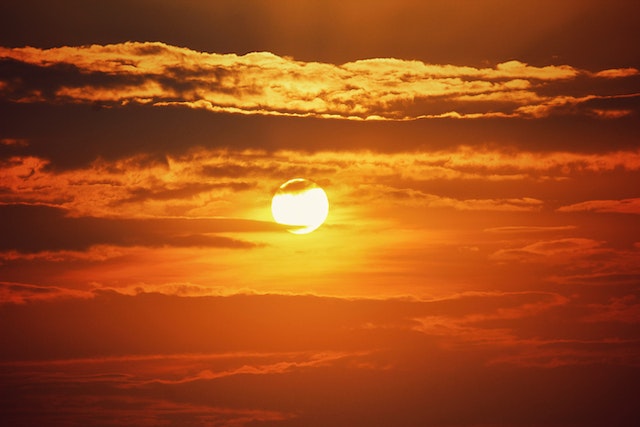
How long did it take for the sun to get hot? Approximately 10 million years for it to start burning. The sun is hot because of nuclear fusion, which is where hydrogen molecules are squashed together under great pressure to make a helium molecule. There is a difference in the atomic weight of the hydrogen molecules and the helium molecule that they become, and this mass is released as energy. This is where the sun’s heat comes from.
Our sun formed from a cloud of gas and dust that was floating in space. The gas was mostly hydrogen and helium. The cloud was about 65 light years across and only a small part of it became our solar system. Nobody knows where this cloud of gas and dust came from. It could be from a previous solar system that had collapsed. It could just be left over gas and dust. There is no way of knowing. The cloud was floating until something started it coalescing into lumps. Again, nobody knows what this was either. It could have been the gravity from a passing star. It could have been a shockwave from an exploding supernova. Whatever the cause, the gas and dust began to clump together and as the lumps grew and gravity grew, they began to grow.
Each one of these growing clumps was about 0.3 light years across. The increasing gravity pulled in the dust and gas in one of the clumps, making the cloud smaller. As it got smaller it started to spin, which pulled more matter into the center of the now spinning disk. The smaller the disk became, the faster it span, which is called the conservation of angular momentum and is the reason ice skaters spin faster when they pull their arms in. The center of the cloud becomes denser and gets bigger. This became the sun.
Most of the matter in the disk was pulled into the center of the disk as it span and the molecules collided with each other producing heat. The center of the disk became very hot, but there was no nuclear fusion yet. After about 100,000 years, enough of the cloud of dust and gas has been compressed together that a protoplanet starts to form. This protoplanet was very hot, but it was heated by the molecular impacts.
The sun is not yet a star. It is still a protostar. It is quite common for protostars to break apart and form binary star systems, but our star stayed in one piece. The protostar was hot, but it would have been nowhere near as bright as the sun we know today. All of the heat was in the outer parts of the the spinning protostar, which meant that it wasn’t very dense. Molecules with energy move far more than those without, which is why hot air is less dense than cold air. In this state, nuclear fusion cannot begin. Over the next ten million years, the protosun loses its heat to space and becomes denser. It gets denser and denser until there is so much pressure at the center that nuclear fusion begins. It is impossible to say how long, but it took anywhere between ten and fifty million years for this to happen.
Like an old-style lightbulb being switched on, it has taken the sun a while to warm up. For the first billion years of its life, it was only about 70% as bright as it is now. In another 1.5 billion years, it will be 15% brighter and hotter than it is right now. That is going to make for difficult living on Earth. Then, when it is 10 billion years old, the sun will be twice as bright as it is now and about 40% bigger. If we have not found a new planet to live on by then, we are going to have to invent some pretty good suncream.
Our sun was large enough to have the necessary gravitational density for nuclear fusion to happen. Jupiter is often called a failed star because it didn’t have enough mass for nuclear fusion to start. However, there are stars in the universe that are smaller than Jupiter, so why can’t it sustain nuclear fusion? The answer comes down to its density. Jupiter may be larger than the smallest star (EBLM J0555-57Ab), but it is a ball of gas that is not dense enough. EBLM J0555-57Ab is smaller than Jupiter because it is much more dense. It is smaller, but it actually has a larger mass than Jupiter. So, unless Jupiter suddenly becomes much more dense, it is not going to ignite.
It took about 10 to 50 million years for the sun to start burning, and the sun is about halfway through its life now. In another 5 billion years or so, the sun will become a Red Giant, before becoming a White Dwarf and then possibly a Black Dwarf. The lifetime of a White Dwarf is longer than the age of the universe, so nobody really knows what will happen. And this is what I learned today.
Photo by CHRISTO JAMES V: https://www.pexels.com/photo/sunset-view-724507/
Sources
https://en.wikipedia.org/wiki/Sun
https://en.wikipedia.org/wiki/Formation_and_evolution_of_the_Solar_System
https://physics.stackexchange.com/questions/265545/how-long-did-it-take-for-the-sun-to-form
https://people.highline.edu/iglozman/classes/astronotes/solsys_form.htm
https://en.wikipedia.org/wiki/Protostar
https://www.swpc.noaa.gov/sites/default/files/images/u2/Chapter_1_mod2-FINAL.pdf
https://www.space.com/19321-sun-formation.html
https://www.sciencealert.com/why-isn-t-jupiter-a-star
https://www.sciencealert.com/astronomers-have-discovered-the-smallest-star-known-to-science
